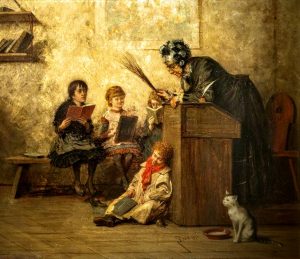PDF #133 – Richard Hogg – An Introduction to Old English, Edinburgh University
An Introduction to Old English – This textbook is designed for students for whom this is the first experience of the language of the earliest period of English. Namely the period from the time of the invasions of Britain by the English in the fifth century until the time of the Norman Conquest. If it is undoubtedly true that the first sighting of the English of that time comes as a shock to most beginning students, there can be no doubt that an understanding of that language is essential for a proper appreciation of how English has evolved over time.
An Integrated Account to An Introduction to Old English
The approach taken here is somewhat different from that usually taken in introductory textbooks of Old English. Most such books offer a two-part solution, consisting, firstly, of a freestanding account of the grammar, and, secondly, a group of texts which the student is expected to read by reference to the relevant material in the grammar.
The distinctive feature of this work is that I have attempted to present an integrated account, in which, for the most part, accounts of the linguistic history of Old English are immediately followed by relevant and exemplary texts. Given the scope of this work, this has meant that some traditional features have had to be omitted.
There are no complete texts, except in one special case, and of necessity. The grammar sections are also not as full as those which some textbooks provide. On the other hand, alongside some features not usually present at this level, such as a discussion of dialectal material, the material presented here is intended to provide the amount of work which can sensibly be covered in one-term or one-semester courses of the kind common today.
Old English
Old English (Englisc, pronounced [ˈeŋɡliʃ]), or Anglo-Saxon, is the earliest recorded form of the English language, spoken in England and southern and eastern Scotland in the early Middle Ages. It was brought to Great Britain by Anglo-Saxon settlers in the mid-5th century, and the first Old English literary works date from the mid-7th century. After the Norman conquest of 1066, English was replaced, for a time, as the language of the upper classes by Anglo-Norman, a relative of French. This is regarded as marking the end of the Old English era, since during this period the English language was heavily influenced by Anglo-Norman, developing into a phase known now as Middle English.
Introduction to Old English – Old English developed from a set of Anglo-Frisian or Ingvaeonic dialects originally spoken by Germanic tribes traditionally known as the Angles, Saxons and Jutes. As the Anglo-Saxons became dominant in England, their language replaced the languages of Roman Britain: Common Brittonic, a Celtic language, and Latin, brought to Britain by Roman invasion. Old English had four main dialects, associated with particular Anglo-Saxon kingdoms: Mercian, Northumbrian, Kentish and West Saxon. It was West Saxon that formed the basis for the literary standard of the later Old English period, although the dominant forms of Middle and Modern English would develop mainly from Mercian. The speech of eastern and northern parts of England was subject to strong Old Norse influence due to Scandinavian rule and settlement beginning in the 9th century.

Old English is one of the West Germanic languages, and its closest relatives are Old Frisian and Old Saxon. Like other old Germanic languages, it is very different from Modern English and impossible for Modern English speakers to understand without study. Within Old English grammar nouns, adjectives, pronouns and verbs have many inflectional endings and forms, and word order is much freer. The oldest Old English inscriptions were written using a runic system, but from about the 8th century this was replaced by a version of the Latin alphabet.
From monk to godspellboc: The influence of Latin on Old English
English vocabulary has never been purely Anglo-Saxon – not even in the Anglo-Saxon period. By the time the Anglo-Saxons arrived in Britain, there had already been four centuries of linguistic interchange between Germanic and Roman people on the European mainland. Latin words might have arrived in English through any of several possible routes. To begin with, they must have entered the Celtic speech of the Britons during the Roman occupation (43–c. 410), and some might have remained in daily use after the Romans finally left in the early 5th century so that they were picked up by the Anglo-Saxons in due course. Aristocratic Britons may also have continued to use the language as a medium of upper-class communication. If so, we might expect a significant number of Latin words to have been in daily use, some of which would have eventually been assimilated into English. Some Latin words would also have been brought in by the Anglo-Saxons invaders. And following the arrival of St Augustine in 597, the influence of the monks must have grown, with Latinisms being dropped into speech much as they still are today.

The Latin words express a considerable semantic range. They include words for plants and animals (e.g. pea, cat), food and drink (e.g. butter, wine), household objects (e.g. cup, candle), money (e.g. mynet, ‘mint’), metals (e.g. copper), items of clothing (e.g. belt, sock), settlements, houses and building materials (e.g. street, wall, tile), as well as several notions to do with military, legal, medical and commercial matters (e.g. tribute, seal, pound). Most are nouns, such as camp, street and monk, with a sprinkling of verbs and adjectives. As we move into the period of early Anglo-Saxon settlement in England, we find these semantic areas continuing to expand, with the growing influence of missionary activity reflected in an increase in words to do with religion and learning.


Place names and loanwords: The Scandinavian influence on Old English
The Vikings first made their presence felt in Britain in the 780s, but it was a further century before Old Norse words began to arrive in Old English. In c. 878–90 King Alfred (c. 849–899) made a treaty with the Viking leader Guthrum (d. 890), which roughly split England into two. Alfred was left in control of Wessex and London, and Guthrum took control over an area of eastern England which, because it was subject to Danish laws, came to be known as the Danelaw. Over 2,000 Scandinavian place-names are still found here, chiefly in Yorkshire, Lincolnshire and the East Midlands. These place-names are one of the most important linguistic developments of the period. Many are easily recognised. Over 600 end in –by, the Old Norse word for ‘farmstead’ or ‘town’, as in Rugby and Grimsby; the other element often referring to a person’s name (Hroca’s and Grim’s farm, in these two cases), but sometimes to general features, as in Burnby (‘farm by a stream’) and Westerby (‘western farm’).
Despite the extensive period of settlement, and Danish becoming the language of power for a generation, the number of Scandinavian words that entered Old English is surprisingly small – about 150. But between Old and Middle English a considerable Scandinavian vocabulary was gradually being established in the language. Although there are no written records to show it, we know that this must have been so because the earliest Middle English literature, from around 1200, shows thousands of Old Norse words being used, especially in texts coming from the northern and eastern parts of the country, such as the Orrmulum and Havelock the Dane. There is no doubt that many of these words were well established, because they began to replace some common Anglo-Saxon words. The word for ‘take’, for example, was niman in Old English; Old Norse taka is first recorded in an English form toc (‘took’) during the late 11th century, but by the end of the Middle English period take had completely taken over the function of niman in general English.
Introduction to Old English – Grammatical change
Old Norse also made a permanent impact on the grammar of the language. The most important of these changes was the introduction of a new set of third-person plural pronouns, they, them and their. These replaced the earlier Old English inflected forms: hi or hie (in the nominative and accusative cases, ‘they/them’), hira or heora (in the genitive case, ‘their, of them’) and him or heom (in the dative case, ‘to them, for them’). Pronouns do not change very often in the history of a language, and to see one set of forms replaced by another is truly noteworthy.
Another grammatical influence was the use of are as the third-person plural of the verb to be. This form had already been used sporadically in northern texts during the late Old English period – for example, in the Lindisfarne Gospels – but in Middle English it steadily moves south, eventually replacing the competing plural forms sindon and be.
Among other Scandinavian grammatical features are the pronouns both and same, and the prepositions til (’till’ or ‘to’) and fro (‘from’). The negative response word, nay, is also Norse in origin (nei). And the –s ending for the third person singular present-tense form of the verb (as in she runs) was almost certainly a Scandinavian feature. In Old English this ending was usually –ð, as in hebbað (‘raises’) and gæð (‘goes’); but in late Northumbrian texts we find an –s ending, and this too spread south to become the standard form.
Introduction to Old English- The transition from Old English to Middle English
The transition from Old English to Middle English is primarily defined by the linguistic changes that were taking place in grammar, with Old English losing most of its inflectional endings, and word order becoming the primary means of expression. There is nonetheless a great deal of continuity between the grammatical systems of Old and Middle English. Word order was by no means random in Old English, nor was it totally fixed in Middle English. We can hear echoes of Old English word order even today. When we meet Yoda in the Star Wars films, we find him regularly inverting his word order, placing the object initially: If a Jedi knight you will become… This was a common Old English pattern – and we do not have any difficulty understanding it a thousand years on.
After reading “An Introduction to Old English”, you can check important issues for ESL teachers on the section PDFs. And visit my channel by YouTube.






